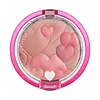Physician's Formula Mineral Wear Talc-Free Mineral Airbrushing Pressed Powder SPF 30 Versus Physician's Formula Happy Booster Glow & Mood Boosting Blush
What's inside
What's inside
 Key Ingredients
Key Ingredients

 Benefits
Benefits

 Concerns
Concerns

 Ingredients Side-by-side
Ingredients Side-by-side

Titanium Dioxide 15%
Cosmetic ColorantZinc Oxide 10%
Cosmetic ColorantMica
Cosmetic ColorantTricaprylin
MaskingBoron Nitride
AbsorbentZinc Stearate
Cosmetic ColorantLauroyl Lysine
Skin ConditioningCalcium Aluminum Borosilicate
Camellia Oleifera Leaf Extract
AstringentChamomilla Recutita Flower Extract
MaskingGinkgo Biloba Leaf Extract
Skin ConditioningPanax Ginseng Root Extract
EmollientCarthamus Tinctorius Seed Oil
MaskingTocopheryl Acetate
AntioxidantRetinyl Palmitate
Skin ConditioningAscorbyl Palmitate
AntioxidantChlorphenesin
AntimicrobialPotassium Sorbate
PreservativeSodium Dehydroacetate
PreservativeIron Oxides
Titanium Dioxide 15%, Zinc Oxide 10%, Mica, Tricaprylin, Boron Nitride, Zinc Stearate, Lauroyl Lysine, Calcium Aluminum Borosilicate, Camellia Oleifera Leaf Extract, Chamomilla Recutita Flower Extract, Ginkgo Biloba Leaf Extract, Panax Ginseng Root Extract, Carthamus Tinctorius Seed Oil, Tocopheryl Acetate, Retinyl Palmitate, Ascorbyl Palmitate, Chlorphenesin, Potassium Sorbate, Sodium Dehydroacetate, Iron Oxides
Talc
AbrasiveZea Mays Starch
AbsorbentDimethicone
EmollientOctyldodecyl Stearoyl Stearate
EmollientZinc Stearate
Cosmetic ColorantPentaerythrityl Tetraisostearate
EmollientAstrocaryum Murumuru Seed Butter
EmollientHelianthus Annuus Seed Oil
EmollientLecithin
EmollientPhytosteryl Canolate
EmollientPlukenetia Volubilis Seed Oil
EmollientRhodiola Rosea Root Extract
EmollientRosmarinus Officinalis Leaf Extract
AntimicrobialTheobroma Grandiflorum Seed Butter
Skin ConditioningSchinus Terebinthifolia Seed Extract
AstringentPalm Alcohol
Skin ConditioningPhenoxyethanol
PreservativePotassium Sorbate
PreservativeParfum
MaskingCI 75470
Cosmetic ColorantIron Oxides
CI 77742
Cosmetic ColorantMica
Cosmetic ColorantCI 15850
Cosmetic ColorantCI 45380
Cosmetic ColorantTitanium Dioxide
Cosmetic ColorantUltramarines
CI 19140
Cosmetic ColorantTalc, Zea Mays Starch, Dimethicone, Octyldodecyl Stearoyl Stearate, Zinc Stearate, Pentaerythrityl Tetraisostearate, Astrocaryum Murumuru Seed Butter, Helianthus Annuus Seed Oil, Lecithin, Phytosteryl Canolate, Plukenetia Volubilis Seed Oil, Rhodiola Rosea Root Extract, Rosmarinus Officinalis Leaf Extract, Theobroma Grandiflorum Seed Butter, Schinus Terebinthifolia Seed Extract, Palm Alcohol, Phenoxyethanol, Potassium Sorbate, Parfum, CI 75470, Iron Oxides, CI 77742, Mica, CI 15850, CI 45380, Titanium Dioxide, Ultramarines, CI 19140
Alternatives
Ingredients Explained
These ingredients are found in both products.
Ingredients higher up in an ingredient list are typically present in a larger amount.
Mica is a naturally occurring mineral used to add shimmer and color in cosmetics. It can also help improve the texture of a product or give it an opaque, white/silver color.
Serecite is the name for very fine but ragged grains of mica.
This ingredient is often coated with metal oxides like titanium dioxide. Trace amounts of heavy metals may be found in mica, but these metals are not harmful in our personal products.
Mica has been used since prehistoric times throughout the world. Ancient Egyptian, Indian, Greek, Roman, Aztec, and Chinese civilizations have used mica.
Learn more about MicaPotassium Sorbate is a preservative used to prevent yeast and mold in products. It is commonly found in both cosmetic and food products.
This ingredient comes from potassium salt derived from sorbic acid. Sorbic acid is a natural antibiotic and effective against fungus.
Both potassium sorbate and sorbic acid can be found in baked goods, cheeses, dried meats, dried fruit, ice cream, pickles, wine, yogurt, and more.
You'll often find this ingredient used with other preservatives.
Learn more about Potassium SorbateTitanium dioxide is a mineral UV filter widely used in sunscreens and cosmetics.
It is one of only two UV filters officially classified as “mineral” by regulatory agencies, the other being zinc oxide.
Titanium dioxide provides broad-spectrum protection mostly in the UVB and UVAII range, with some protection in the UVAI range.
While its UVA protection isn’t as strong as zinc oxide’s, the difference is minor.
A common myth is that mineral UV filters reflect UV light. However, modern research shows titanium dioxide absorbs UV radiation like chemical filters (~95% absorption & 5% reflection).
Thanks to its non-irritating nature, titanium dioxide is suitable for sensitive, acne-prone, or redness-prone skin. It is unlikely to cause "eye sting" like other sunscreen ingredients.
A major drawback of this ingredient is its white cast and thick texture. This is why mineral sunscreens often leave a white cast and are less cosmetically elegant than chemical/hybrid sunscreens.
To improve white cast and spreadability, micronized or nano-sized titanium dioxide is often used.
There are ongoing concerns surrounding nano-titanium oxide's impact on marine ecosystems.
There is no conclusive evidence that any form of titanium oxide (or any other sunscreen ingredients) will cause harm to marine ecosystems or coral reefs. The science is still developing but many consumers are keeping a close eye on this issue.
Please note, many destinations have reef-safety sunscreen rules. For instance, the U.S. Virgin Islands advises all visitors to use non-nano mineral sunscreens.
Nano mineral sunscreens once raised safety concerns about absorption into skin.
Extensive research has shown that they do not penetrate healthy or damaged skin; they remain safely on the surface and the top layer of dead skin (stratum corneum).
You'll likely find titanium dioxide bundled with alumina, silica, or dimethicone. These ingredients help make titanium dioxide highly photostable; this prevents it from interacting with other formula components under UV light.
Learn more about Titanium DioxideZinc Stearate is the metal salt of stearic acid. It is a white solid used to bind, thicken, and lubricate products.
This ingredient is common in powder makeup, where it helps keep the powder together.
Zinc Stearate is hydrophobic and repels water.
This ingredient can be sourced from non-animal or animal sources. It is best to reach out to the brand to see where they source this ingredient from.
Learn more about Zinc StearateThis ingredient is a combination of red, black, and yellow iron oxide pigments. This combination of colors is usually found in foundation, because it results in a "skin" color.